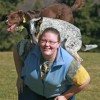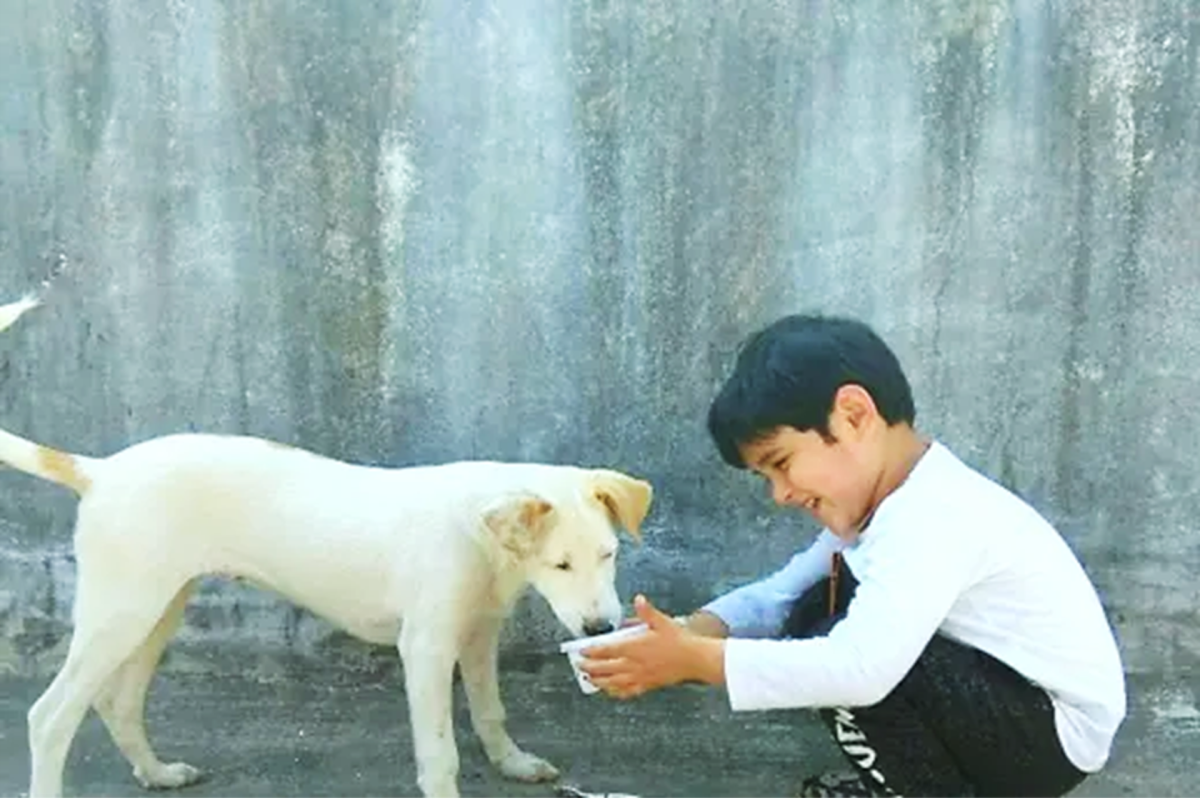Fido, Stop That!
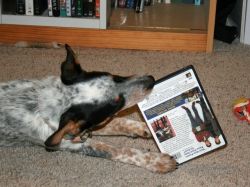
Dealing With Unwanted Behaviors
Although I am a professional trainer, my dogs have not always been perfect--okay they still aren't perfect, but they are pretty awesome. They have each had their own challenges and less than desirable behaviors over the years. Their behavior challenges have ranged from normal puppy challenges like inappropriate chewing, potty training, and barking to more serious behaviors like resource guarding, fear aggression, and reactivity.
While I approach each training issue individually, there are certainly things that I use for nearly every training plan I put in place. These are like the ingredients in a good recipe base, so to speak. It's sort of like Bisquick--from this one pre-packaged base mix, you can make pancakes, garlic biscuits, chicken fingers, shortcake, pot pies, Boston cream pies, and more. This training recipe base mix is important for handlers and guardians to know because it can be used to triage situations until a customized recipe has been developed.
There are three main ingredients in my base recipe for dealing with unwanted behaviors--prevent the dog from practicing the behavior, teach an incompatible behavior, and increase mental and/or physical exercise. Depending on the situation or the behavior, I will do more or less of each of these and most of the time I'm adding in other training ingredients but these are really great foundation pieces to dealing with a wide variety of unwanted behaviors.
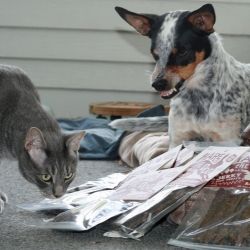
Prevention Is Key
"Practice makes perfect" is phrase that most people have encountered at some point in their lives and it really is true. The more we practice anything the better or more efficient we become. It is absolutely no different with dogs--the more they practice a behavior, any behavior, the better or more efficient they get. Unfortunately this applies to both desirable and undesirable behaviors.
Each time a dog is allowed to rehearse or practice the unwanted behavior, they will get better at it and be more likely to do it in the future. Every time you allow your pup to potty inside, jump on your mother in law, chew your spouse's favorite pair of shoes, ignore your recall, or pull on the leash, you are setting yourself up to have it happen again in the future.
Depending on the situation you are dealing with, you will utilize different methods of prevention. Below are some common problems that I am called in to help with and some of the preventative solutions that I use as immediate triage.
Potty Training Troubles--use a crate, an xpen, or umbilical leash system to prevent your dog from having the opportunity to make a mistake (they cannot slip away and potty without you noticing). Getting your dog on a schedule and letting him or her out frequently (hourly or every half hour to start) can help prevent them from having any accidents inside.
Chewing Inappropriate Items--puppy proof a room to limit their access to inappropriate items; put shoes, books, remotes, power supply cords, and pillows out of reach. Make sure you provide a wide variety of appropriate chew items--think about having toys and chews of various materials, textures, and flavors. You can also utilize an xpen to provide a puppy proofed area that you can fill with lots of appropriate chew items without having to puppy proof a whole room.
Pulling on Leash--depending on your situation, you may be able to use other forms of exercise to get your pup what they need while temporarily not going on normal walks--any walk you take should be about training until your pup understands that pulling gets him/her nowhere. You can also use a tool like a front-attaching harness (Sense-ation or Freedom no-pull) to prevent the dog from being able to pull as hard (or learning to pull harder) if you have to take the dog for a walk.
Jumping Up on People--depending on the environment causing the most problems (jumping up on strangers while on a walk, or visitors to your home, or your own family members), there are different things to try. While on walks, do not allow anyone to pet your pup--if they ask to pet, say "Thanks for asking but no, he's in training because he likes to jump up," it only takes one person to reward your pup for jumping up to undo all of your training (once you've done some training you can let people pet your pup). At home, use a leash when visitors come over so your pup cannot jump up on them, only let him go say hi when he has calmed down. Alternatively, you can keep your pup behind a gate until he/she is calm enough to greet your visitors.
Resource Guarding (growling/snapping around their food bowl, toys, chews, or other objects)--If they are guarding a specific object (rawhide, ball, food bowl, or couch) remove that object from the environment for the time being. If it's a food bowl, feed them by hand or just put the kibble on a towel on the ground. If it's furniture, do not allow them to have access to it.
Incompatible Behaviors
Although some situations can be resolved simply by preventing the unwanted behavior, many require a little bit more work to be resolved. In many situations, teaching incompatible behaviors can be a great solution for dealing with unwanted behaviors in addition to prevention.
We want to teach dogs what we would rather them do instead of the unwanted behavior. In order for this to be really effective we have to commit to preventing the dog from practicing the unwanted behavior while we teach them the desired alternative. If sometimes they do the unwanted behavior and get rewarded for it (a person pets them while they jump up, they steal snacks off the counter, they get where they want to go while pulling), they will keep trying it since sometimes it pays out. A good example are the scratch off lottery tickets, if people never won, they would stop playing because it doesn't pay out--lottery executives know this so they put out enough low level winners to keep people coming back because they get rewarded, even if rarely. You need to make sure that the pup never wins if they perform the unwanted behavior while you teach what you would rather they do.
Let's look at some common issues and some easy solutions.
Jumping Up On Visitors--What you really want is for your dog to sit nicely for petting. So, while preventing him/her from jumping up on visitors, practice heavily reinforcing the dog for sitting by letting him say high if his bum is on the ground. The more he gets what he wants through sitting and doesn't get what he wants by jumping, the more he'll choose to sit.
Stealing food from tables/counters (while you are home)--What you'd rather him do is lay on his mat while you prepare dinner. When you are not actually eating or cooking, practice teaching Fido to lay on a mat in the area where food stealing happens. Heavily reward choosing the mat/bed, eventually start practicing rewarding good choices while you are eating or preparing a meal--it pays out to stay on the mat instead of counter surfing.
Puppy Mouthing--What you'd prefer is him finding a toy to play with. When puppy starts mouthing nothing fun happens or the human may even cross a barrier to leave the pup but we want to heavily reinforce choosing to pick up toys and play with toys instead. A handler could even choose to teach a dog to "get a toy" as an incompatible behavior to mouthing. Toys=play, chomping on mom/dad=no fun.
Car Chasing--What you'd like your pup to do is sit or down instead of bark and lunge at passing cars. Starting at whatever distance away from the cars the dog needs to be to think/respond to cues, start requesting the sit or down each and every time the dog sees a car (what you choose to reward the dog with could be anything from high level food to playing with a flirt pole)--slowly decrease the distance between the pup and the car as long as the dog is still successful at holding the sit or down.
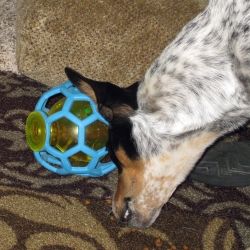
Enrichment Games and Exercise
There are many situations that can be improved by adding mental or physical exercise (or both) to the daily routine of the dog. Many dogs aren't getting the physical exercise that they really need to be happy and satisfied but I would argue that most dogs are seriously lacking in mental exercise. Not all unwanted behaviors can be aided with additional mental and physical work, but many of them can be helped.
Depending on the situation, adding a walk, adding a 10 minute fetch session, adding a flirt pole session (with impulse control training), or adding a game of tug (with impulse control training), can be enough to make a big difference. Some situations and some dog breeds will need more than others but adding more physical exercise is not a big mystery for most people, it's just a matter of doing it and getting it done.
Mental exercise or enrichment activities are a bit more foreign for guardians but they are actually pretty fun and easy once you get the idea! Basically, mental exercise is all about brain work. Finding games or activities that require your dog to think and problem solve. A dog who is mentally tired is less likely to get themselves into trouble with some unwanted behaviors.
The best and easiest suggestion is to ditch the food bowl. Instead of freebie dinners, use meals as opportunities for mental work.
One way to increase mental exercise is to do training sessions as a way for your pup to earn their dinner piece by piece. They'll be both physically and mentally tired out after using many short training sessions for them to earn their meals or part of their meals.
Using kibble dispensing toys are some of my favorite mental exercise for dogs. It's simple for the humans and it's not at all time consuming. Instead of pouring their kibble into a bowl, put it into a toy or two for the pup to play with and figure out how to get their dinner while you eat your own dinner, get ready for work, tend to the kids, or relax and read a book.
Kibble dispensing toys come in a wide variety of shapes, sizes, and difficulty levels. It's important to start with easy toys so the dog learn the game of manipulating toys to get their dinner. If you start with a challenging toy, most dogs will give up because they aren't getting the kibble out fast enough.
EASY TOYS
Kong Wobbler
JW Holee Treat Ball
Molecule Ball
Treat Stick
Orbee Ball with holes in it
Various brands and types of balls that have openings and can be filled with kibble
Kong Classic with kibble (super easy)
1 Gallon water bottle with several 2" holes cut in the sides
MEDIUM LEVEL TOYS
Tug-a-Jug
I.Q. Treat Ball (multiple settings)
Buster Cube (multiple settings)
1 Gal bottle with a couple 1" holes
Kyjen Cross Slider
Cardboard box with the flaps folded over to close the box
Kong Classic with kibble soaked with water stuffed inside and then frozen
2ft long 2-3" PVC pipe with several holes drilled in the sides with end caps
DIFFICULT LEVEL TOYS
I.Q. Treat Ball (most challenging level)
Buster Cube (most challenging level)
1 gal bottle with the lid off and no holes
Cardboard box taped shut (dogs will destroy box to get inside but it's all work!)
2ft long 2-3" PVC pip with a couple holes drilled in the sides with end caps
Besides toys, you can also explore interactive puzzles or games with your dog. These are more time consuming as they are interactive but are equally as fun and mentally tiring!
Any number of the Nina Ottoson Puzzles
Muffin Tin Game--put kibble in a muffin tin and cover the holes with tennis balls as the easiest level
Shell Game --kibble under 1 of 3 cups, pup has to find the right cup
Egg Game--hide kibble in plastic Eggs and the pup has to find the eggs (or which eggs have kibble)
Kyjen Puzzle toys
Kibble hunts
Favorite Puzzle Toys on Amazon
Remember that although kibble dispensing toys can be used independently by the dog (once filled), it's still important to supervise your dog's play. Interactive puzzle toys are designed to be used with dog and guardian playing together, these require more time and focus from the human to help the dog work through the puzzles or refill it for another round.


